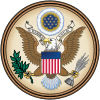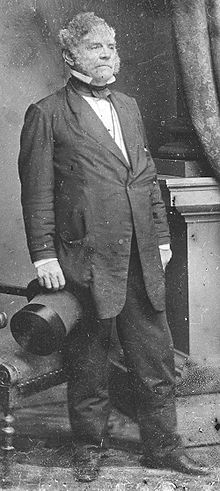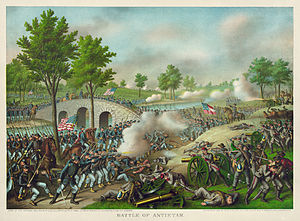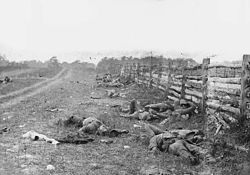- Maryland in the American Civil War
-
See also: American Civil War, Origins of the American Civil War, and Heart of the Civil War Heritage Area

Union States
in the
American Civil WarCalifornia
Connecticut
Illinois
Indiana
Iowa
Kansas
Maine
Massachusetts
Michigan
Minnesota
Nevada
New Hampshire
New Jersey
New York
Ohio
Oregon
Pennsylvania
Rhode Island
Vermont
WisconsinBorder states Delaware
Maryland
West VirginiaDual governments Territories Arizona
Colorado
Dakota
Idaho
Montana
Nebraska
New Mexico
Utah
WashingtonIn the American Civil War, Maryland, a slave state, was one of the border states, straddling the North and South. Due to its location and a desire from both opposing factions to sway its population to their respective causes, Maryland played an important role in the American Civil War. The first fatalities of the war happened during the Baltimore Riot of 1861, and the single bloodiest day of combat in American military history occurred near Sharpsburg, Maryland, at the Battle of Antietam, which provided the opportunity for President Abraham Lincoln to issue his famed Emancipation Proclamation. The 1864 Battle of Monocacy helped delay a Confederate army bent on striking the Federal capital of Washington, D.C..
Nearly 85,000 citizens signed up for the military, with many joining the Union Army, although just over a third of these enlisted to fight for the Confederacy. Leading Maryland leaders and officers during the Civil War included Governor Thomas H. Hicks, who despite his early sympathies for the South, helped prevent the state from seceding, and General George H. Steuart, who was a noted brigade commander under Robert E. Lee.
Contents
Maryland's sympathies
Maryland, as a slave-holding border state, had remained relatively neutral in the antebellum squabbling over states rights and the sovereignty of the Federal government. However, in the lead up to the American Civil War, it became clear that the state was unsympathetic towards the potentially abolitionist position of Abraham Lincoln, as in the presidential election of 1860 only 2.5% of the votes were cast for Lincoln. The 1860 Federal Census[1] showed there were nearly as many free blacks (83,942) as slaves (87,189) in Maryland. After John Brown's raid on Harper's Ferry, citizens began forming local militias. Of its 1860 population of 687,000, about 60,000 men joined the Union and about 25,000 fought for the Confederacy. Southern and Eastern Maryland were especially close to the South, while northern and western areas of the state had stronger economic ties to the North. However, some northern Marylanders such as John Wilkes Booth, General James J. Archer, and some Shrivers of Union Mills were pro-Confederate. Likewise, a Robert E. Lee memorial is in Baltimore, a home for retired Confederate soldiers was in Pikesville, and the courthouses in Rockville and Easton have Confederate monuments. The mayor and other leading citizens of Baltimore were imprisoned at Fort McHenry by Union forces.
The first bloodshed of the Civil War occurred in Baltimore City and was known as the "Pratt Street Riot." The incident involved Massachusetts troops that were fired on while marching between railroad stations in the city on April 19, 1861. After that, Baltimore Mayor George William Brown, Marshal George P. Kane, and former Governor Enoch Louis Lowe requested that Maryland Governor Thomas H. Hicks, a slave owner from the Eastern Shore, burn the railroad bridges and cut the telegraph lines leading to Baltimore to prevent further troops from entering the state. Hicks reportedly approved this proposal. These actions were addressed in the famous Supreme Court case of Ex parte Merryman.
However, despite considerable popular support for the cause of the Confederate States of America, Maryland did not secede during the United States Civil War. Subsequently, many prominent men lobbied Hicks to call the General Assembly into special session, purportedly for the mixed reason of opposing secession and opposing the Northern attitude towards the South. Initially called into session in Annapolis, Hicks changed it to Frederick. Annapolis was a Southern Democratic town, and secessionist, and Frederick was Unionist. Additionally, many legislators and Southern sympathizers were arrested by Lincoln. The legislature convened in Frederick unanimously adopted a measure stating that they would not commit the state to secession, "even though we have the constitutional authority to take such action." Thousands of Union troops were stationed in Charles County, and the Union established a large, unsheltered prison camp at Point Lookout at Maryland's southern tip where thousands of Confederates died in misery. The Annapolis suburb of Parole was a camp where paroled Union prisoners-of-war would await formal exchange.
Many Marylanders sympathetic to the South easily crossed the Potomac River to join and fight for the Confederacy. Exiles, including brigadier general George H. Steuart, organized a "Maryland Line" in the Army of Northern Virginia which consisted of one infantry regiment, one infantry battalion, two cavalry battalions and four battalions of artillery. According to the best extant records, up to 25,000 Marylanders traveled south to fight for the Confederacy while about 60,000 Maryland men served in all branches of the Union military. One notable Maryland front line regiment was the 2nd Maryland Infantry, which saw considerable combat action in the Union IX Corps.
Because Maryland remained in the Union it was not included under the Emancipation Proclamation. A constitutional convention was held during 1864 that culminated in the passage of a new state constitution (see below) on November 1 of that year. Article 24 of that document outlawed the practice of slavery. The right to vote was not extended to non-white males until the Maryland Constitution of 1867, which is still in effect today.
Baltimore Riot of 1861 and aftermath
Main article: Baltimore riot of 1861
The first bloodshed of the Civil War occurred in Maryland. Concerned about the Confederates capturing the capital, Washington, D.C., President Lincoln ordered troops to defend the city. They were transported by rail to Baltimore, where they had to disembark, march through the city, and board another train to continue their journey south to Washington. As one Massachusetts regiment was transferred between stations on April 19, a mob of secessionists and Southern sympathizers attacked the train cars and blocked the route. The mob began throwing stones and bricks at the troops. Panicked by the situation, several soldiers fired into the mob, and chaos immediately ensued as a giant brawl began between fleeing soldiers, the violent mob, and the Baltimore police who tried to suppress the violence. Four soldiers and twelve civilians were killed in the riot. This event inspired James Ryder Randall to write a poem which would be put to music and eventually become the state song, "Maryland, My Maryland".
After the April 19 rioting, some small skirmishes continued in Baltimore for the next month, but a sense of normalcy returned as the city was cleaned up. Mayor George William Brown and Maryland Governor Thomas Hicks implored President Lincoln to reroute troops around Baltimore city and through Annapolis to avoid further confrontations. On the evening of April 20 Hicks also authorized Brown to dispatch the Maryland state militia for the purpose of disabling the railroad bridges into the city - an act he would later deny. One of the militia captains was John Merryman, who was arrested without a writ of habeas corpus one month later, sparking the case of Ex parte Merryman.
Lincoln complied with the request to reroute troops to Annapolis at first. However, on May 13, the Union army entered Baltimore, occupied the city and declared martial law, to prevent all further incidents. The mayor, city council, and police commissioner, who were pro-South, were arrested and imprisoned at Fort McHenry. However, in the case Ex parte Merryman, these actions were deemed unconstitutional.
After the occupation of the city, Union troops were garrisoned throughout the state. Several members of the Maryland legislature were also unlawfully arrested, and the state was placed under Federal martial law.
Constitution of 1864
These issues were all brought up by the constitution which the state adopted in 1864. The document, which replaced the Maryland Constitution of 1851 was largely the product of Unionists who temporarily had control of the state and was designed to reduce the influence of Southern sympathizers, who had almost caused the state to secede in 1861. The document emancipated the state's slaves (who were not covered by the Emancipation Proclamation), disenfranchised southern sympathizers, and reapportioned the General Assembly based upon white inhabitants. This last provision diminished the power of the small counties where the majority of the state's large former slave population lived.
The constitution was submitted to the people for ratification on October 13, 1864 and it was narrowly approved by a vote of 30,174 to 29,799 (50.31% to 49.69%). This was a very controversial result, given the state's Confederate ties and sympathies. Those voting at their usual polling places were opposed to the Constitution by 29,536 to 27,541. However, it secured ratification after the soldiers' votes were tallied. Soldiers from Maryland serving in the Union Army were overwhelmingly in favor (2,633 to 263). Of course, the state's soldiers who fought for the Confederacy, who would have overwhelmingly opposed it, could not vote in the referendum.
While the constitution emancipated the state's slaves, this did not mean equality for them, in part because the franchise was restricted to "white" males. Additionally, the Maryland legislature refused to ratify both the 14th Amendment, which conferred citizenship rights on former slaves, and the 15th Amendment, which gave the vote to African Americans.
The war on Maryland soil
In the Civil War the largest and most significant battle fought in the state was the Battle of Antietam, fought on September 17, 1862, near Sharpsburg. The battle was the culmination of Robert E. Lee's Maryland Campaign, which aimed to secure new supplies; recruit fresh men from among the considerable pockets of Confederate sympathies in Maryland; and to impact public opinion in the North. With those goals, Lee's Army of Northern Virginia, consisting of about 40,000 men, had entered Maryland following their recent victory at Second Bull Run.
While Major General George B. McClellan's 87,000-man Army of the Potomac was moving to intercept Lee, a Union soldier discovered a mislaid copy of the detailed battle plans of Lee's army. The order indicated that Lee had divided his army and dispersed portions geographically (to Harpers Ferry, West Virginia, and Hagerstown, Maryland), thus making each subject to isolation and defeat in detail if McClellan could move quickly enough. McClellan waited about 18 hours before deciding to take advantage of this intelligence and position his forces based on it, thus endangering a golden opportunity to defeat Lee decisively.
The armies met near the town of Sharpsburg by the Antietam Creek. Although McClellan arrived in the area on September 16, his trademark caution delayed his attack on Lee, which gave the Confederates more time to prepare defensive positions and allowed Longstreet's corps to arrive from Hagerstown and Jackson's corps, minus A.P. Hill's division, to arrive from Harpers Ferry. McClellan's two-to-one advantage in the battle was almost completely nullified by a lack of coordination and concentration of Union forces, which allowed Lee to shift his defensive forces to parry each thrust.
Although a tactical draw, the Battle of Antietam is considered a strategic Union victory and a turning point of the war because it forced the end of Lee's invasion of the North and it allowed President Lincoln to issue the Emancipation Proclamation, taking effect on January 1, 1863. Although Lincoln had intended to do so earlier, he was advised by his Cabinet to make this announcement after a Union victory to avoid the perception that it was issued out of desperation. The winning of the Battle of Antietam also may have dissuaded the governments of France and Great Britain from recognizing the Confederacy; some suspected they were planning to do so in the aftermath of another Union defeat.
In 1864, elements of the warring armies again met in Maryland, although this time the scope and size of the battle was much smaller than Antietam. The Battle of Monocacy was fought on July 9, just outside Frederick, as part of the Valley Campaigns of 1864. Confederate forces under Lt. Gen. Jubal A. Early defeated Union troops under Maj. Gen. Lew Wallace. The battle was part of Early's raid through the Shenandoah Valley and into Maryland, attempting to divert Union forces away from Gen. Robert E. Lee's army under siege at Petersburg, Virginia. However, Wallace delayed Early for nearly a full day, buying enough time for Ulysses S. Grant to send reinforcements from the Army of the Potomac to the Washington defenses.
See also
- List of Maryland Civil War Union Units
- List of Maryland Civil War Confederate Units
- Maryland Line (CSA)
- History of the Maryland Militia in the Civil War
References
- Maryland State Archives (16 Sept. 2004).Historical Chronology.
- Dennis C. Curry (2001). "Native Maryland, 9000 B.C.-1600 A.D.".
- Whitman H. Ridgway. Maryland Humanities Council (2001). "(Maryland in) the Nineteenth Century".
- David Hein, editor. Religion and Politics in Maryland on the Eve of the Civil War: The Letters of W. Wilkins Davis. 1988. Rev. ed., Eugene, OR: Wipf & Stock, 2009.
External links
American Civil War (outline) Origins - Combatants
- Theaters
- Campaigns
- Battles
- States
CombatantsTheatersMajor battles- Fort Sumter
- 1st Bull Run
- Wilson's Creek
- Fort Donelson
- Pea Ridge
- Hampton Roads
- Shiloh
- New Orleans
- Corinth
- Seven Pines
- Seven Days
- 2nd Bull Run
- Antietam
- Perryville
- Fredericksburg
- Stones River
- Chancellorsville
- Gettysburg
- Vicksburg
- Chickamauga
- Chattanooga
- Wilderness
- Spotsylvania
- Cold Harbor
- Atlanta
- Mobile Bay
- Franklin
- Nashville
- Five Forks
Involvement
by state or territoryLeaders ConfederateMilitaryCivilianUnionMilitaryCivilianAftermath - Alabama Claims
- Carpetbaggers
- Freedman's Bank
- Freedmen's Bureau
- Jim Crow laws
- Redeemers
- Southern Claims Commission
Cemeteries- Confederate memorials and cemeteries
- National cemeteries
- U.S. memorials and cemeteries
VeternsOther topics- Related topics
- Categories
Related topicsMilitaryPoliticalOther topicsCategories- American Civil War
- People
- Battles
- Union Army generals
- Union armies
- Union Army corps
- Confederate States of America (CSA)
- Confederate Army generals
- Confederate armies
- Spies
- National Battlefields
- Veterans' organizations
- Medicine
- Museums
- Forts
- Old soldiers' homes
- Prisons
- Reconstruction
- U.S. memorials and cemeteries
- Confederate memorials and cemeteries
American Civil War at sister projects  American Civil War portal
American Civil War portal Military History: American Civil War
Military History: American Civil War Special Project: Brothers at War
Special Project: Brothers at War
Categories:
Wikimedia Foundation. 2010.




